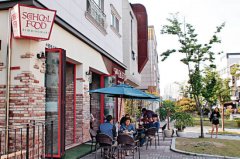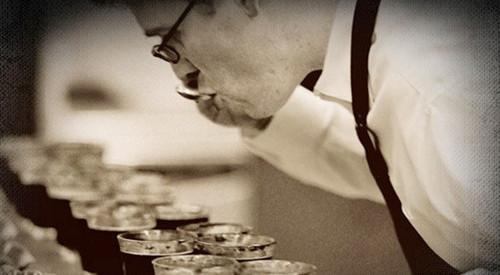No coffee shop, no NYSE?
The relationship between coffee and finance began with the multiplication of coffee shops in London in 1650. At that time, each group, political party or fashion genre had its own cafe where it often met. The news from all over Europe has a great impact on the economic trend, and the best place to get the news is the cafe with a fast flow of people. The news affects the stock price, and many businessmen are eager to buy or sell shares as soon as they hear the news, so the cafe has gradually become the most active place for stock trading.

London: the banished broker walks into a cafe
At that time, stock investors and brokers often visited the Jonathan Cafe and Greyway Cafe near the palace.
The Jonathan Cafe in Chais Hutong is home to 150 "deported" brokers who were expelled from the Royal Stock Exchange in 1698 because of their uproar. John Kastain, a broker, made a pamphlet called "the process of Trading and other matters" to improve efficiency when trading stocks at Jonathan Cafe. Listed above is a list of the prices of stocks and commodities he holds for reference by other brokers. Such pamphlets immediately became popular, and many brokers followed his lead in providing such lists. The cafe then published such a list on the bulletin board in the cafe-which was the beginning of the listing of shares.
After the panic of 1745 and the fire of 1748, it was rebuilt and renamed the New Jonathan Cafe in 1761. Soon, however, it had a new name, the London Stock Exchange, which has been in use today and has become the absolute center of the world's finance.
By contrast, the Greyway Cafe is much more unfortunate. It was active in the South China Sea Bubble from 1719 to 1721. Investors are in a speculative frenzy. Swift, one of the investment losers of the Nanhai bubble and author of Gulliver's travels, said of Greyway Cafe: "there are thousands of subscription orders here, like countless sampans pushing me on the surface of the sea. Everyone is shaking his leaky boat and is not afraid to drown in order to catch gold."
When the bubble burst, the whole of London entered a financial winter, talking about a change in color. Greyway Cafe, which was overcrowded that day, also lost its reputation.
Unlike the cafes that eventually became the London Stock Exchange and the New York Stock Exchange, Greyway Cafe lost its reputation in the South China Sea Bubble.
New York: plane trees are as important as cafes
Before 1653, when Wall Street was not a street, a group of Dutch immigrants erected a 12-foot log wall at the southern tip of the island of Manhattan, hoping to protect themselves from Indians and British attacks. 32 years later, city planners named the street WallStreet.
After a hundred years, Dutch immigrants gradually lost control of the city, but their qualities of business, speculation and risk-taking have seeped into the bloodline of Manhattan. On May 17, 1792, 24 stockbrokers gathered under a plane tree in front of 68 Wall Street and signed the famous "plane Tree Agreement" after negotiation.
Since then, they met regularly under the tree and traded securities only with brokers who signed the agreement, forming an independent and privileged alliance of securities trading.
In 1793, the broker moved into Tongting Cafe, which was only 30 meters away from the tree. Tongting Cafe has also become a trading place for these brokers on rainy days. At its peak, Tongting Cafe was the largest stock exchange in New York City. People gather here to discuss the prices of all kinds of commodities and stocks. In 1807, John Lambert, a British tourist, wrote: "Tongting Cafe is full of stockbrokers, underwriters, businessmen, wholesalers and politicians." They talk business, buy and sell. Outside the cafe, all the way to the corner of Wall Street and Pearl Street, it was full of two-wheelers, wagons and wheelbarrows. Everything is full of vitality, non-stop. "
Interestingly, political disputes do not seem to be common in this cafe. During the French Revolution, in various public places in New York, pro-Anglophile and pro-French often quarreled and even struck an old fist. But Tongting Cafe, this phenomenon is rare, only once, supporters of the French revolution held a party in Tongting Cafe, and caused a dispute. This is in the news because most of the time, partisanship can't get into Tongting Cafe, where only business is the eternal topic.
On a thunderstorm night 73 years later, the plane tree was knocked down by a storm, but the plane Tree Agreement continued to work in the Tongting Cafe. In 1817, brokers involved in securities trading in Tongting Cafe adopted a formal constitution to establish the New York Stock Exchange, which is today's New York Stock Exchange. the regulations of the New York Securities and Exchange Management Service drafted by members on its basis will also become a template for all future stock exchange statutes, including the spirit of membership, unified commission and alliance mutual aid. To this day, it is still the basic rule of the securities trading market, and it reconnects the discrete hearts of the people after several financial crises.
Excerpt from the first Reading
Important Notice :
前街咖啡 FrontStreet Coffee has moved to new addredd:
FrontStreet Coffee Address: 315,Donghua East Road,GuangZhou
Tel:020 38364473
- Prev

The first regional mass creative space alliance was born in Shanghai.
Let's go, guys, let's have a coffee on the first floor! just after 11:00 on March 29th, the country's first regional mass innovation space alliance was established in the Shanghai Science and Technology Entrepreneurship Center. Walking out of the lecture hall on the fifth floor, the entrepreneurial partner is still unsatisfied.
- Next

Teach you how to grade coffee. What is the special talent of coffee tasters?
What is the special talent of coffee tasters? How can a cup of coffee be quantified into a standard? Lao he revealed the secrets for you one by one. Drink hundreds of cups of coffee a day according to the arrangement of the organizing committee, in this competition, the judges will drink six to eight rounds of single coffee (pure coffee made from coffee beans without milk sugar) every day, and there will be six to eight groups of coffee in each round. Each group should drink 5 cups, each cup of coffee at least
Related
- Why can American refills for free? The difference between Americano and American drip pot coffee
- Being chased out of the rain in front of Starbucks?! Store: Sheltering from rain under umbrellas poses a safety hazard
- The white moonlight has changed?! Lucky launches "Big Winter Pear American"
- Hand-brewed coffee three-stage method, high-sweet and universal brewing method to share! What does the high sweet water level of hand-brewed coffee mean?
- What is the difference between raw, refined and full espresso coffee? How to extract espresso and taste good?
- A complete list of coffee bean names and their meanings! What is Yejia Shefi coffee? Where is Mantelin coffee?
- What grade does Arida Manor Kaduai coffee beans belong to? What treatment is Arida ASD slow anaerobic sun exposure?
- The milk tea cup becomes smaller?! Overlord Tea Girl launches a new "Return to Yunnan" series
- Accused of selling counterfeit and high-priced coffee beans! Well-known boutique coffee brand "Oukelao" bowed and apologized!
- How to make espresso dumplings? Can I eat coffee and glutinous rice balls together?

